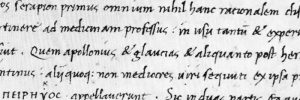CHARLEMAGNE’S EARLY YEARS
Charlemagne was born around 742, the son of Bertrada of Laon (d.783) and Pepin the Short (d.768), who became king of the Franks in 751. Charlemagne’s exact birthplace is unknown, although historians have suggested Liege in present-day Belgium and Aachen in modern-day Germany as possible locations. Similarly, little is known about the future ruler’s childhood and education, although as an adult, he displayed a talent for languages and could speak Latin and understand Greek, among other languages.
After Pepin’s death in 768, the Frankish kingdom was divided between Charlemagne and his younger brother Carloman (751-771). The brothers had a strained relationship; however, with Carloman’s death in 771, Charlemagne became the sole ruler of the Franconians.
Carolingian minuscule, in calligraphy, clear and manageable script that was established by the educational reforms of Charlemagne in the latter part of the 8th and early 9th centuries. As rediscovered and refined in the Italian Renaissance by the humanists, the script survives as the basis of the present-day Roman upper- and lowercase type.
A learned English cleric, Alcuin of York, was invited in 781 by Charlemagne to become master of the palace school at Aachen (Aix-la-Chapelle). He returned to England in 786 and again in 790, but he eventually retired as abbot of St. Martin’s at Tours, where he built up a monastic school and gathered many books. He is credited with Roman Catholic liturgical reforms and with the promotion of Carolingian minuscule as the official court hand.
The crowning achievement of the Tours school of scholars, Carolingian minuscule scribes, and artists was attained in the mid-9th century in theGospels of Lothair, produced by Alcuin’s successors.
LATIN-ALPHABET HANDWRITING
To understand the development of modern Western calligraphy it is important to survey historical writing styles—some of which profoundly influenced subsequent work—as well as how the materials of writing have been used. Most calligraphy is done with pen and ink on paper or parchment, although brushes and chisels are also used for making large letters on various surfaces. Later judgments about how the tip of a pen (usually a quill or reed) was cut, the angle at which it was held, and the formation of individual letters are conjectures based on the evidence of images of people writing.
BLACKLETTER GOTHIC STYLE
What is Gothic? Gothic was the culminating artistic expression of the middle ages, occurring roughly from 1200—1500. The term Gothic originated with the Italians who used it to refer to rude or barbaric cultures north of the Italian Alps.
According to Christopher Wren’s Saracenic Theory, Gothic style had nothing to do with the Goths, rather it was a style influenced by a number of factors includingSaracenic art —an Islamic influence from the Crusades.
The Gothic spirit took hold in France, Germany and England where it was manifested through unhindered upward striving: the vertical supplanted horizontals as the dominant line in architecture; the pointed arch replaced the round arch of the Romans; the almond shape, or mandorla, was preferred. Gothic writing forms reflected this aesthetic.
Bibliography
http://www.history.com/topics/charlemagne
https://www.britannica.com/art/Carolingian-minuscule
http://www.designhistory.org/Handwriting_pages/Blackletter.html



